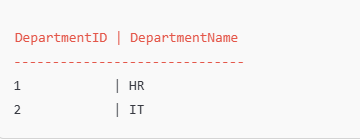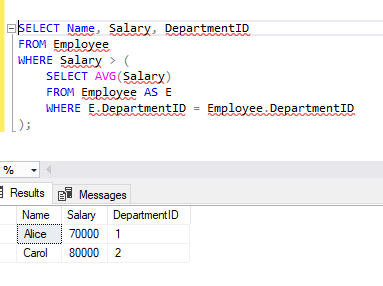A nested subquery in SQL is a query within another query. The inner query (subquery) is executed first, and its result is used by the outer query.
Here’s a classic example using a nested subquery to find employees earning more than the average salary of their department.
Example
Schema
Consider the following two tables:
- Employees

2. Department


Query
Find employees who earn more than the average salary of their department:
SELECT Name, Salary, DepartmentID
FROM Employees
WHERE Salary > (
SELECT AVG(Salary)
FROM Employees AS E
WHERE E.DepartmentID = Employees.DepartmentID
);
Explanation
- Inner Query:
SELECT AVG(Salary) FROM Employees AS E WHERE E.DepartmentID = Employees.DepartmentID- Calculates the average salary for a specific department (filtered by
DepartmentID).
- Calculates the average salary for a specific department (filtered by
- Outer Query:
SELECT Name, Salary, DepartmentID FROM Employees WHERE Salary > (...);- Retrieves employees whose salary is greater than the department’s average salary.
Output
Based on the data:
Name | Salary | DepartmentID
--------------------------------
Alice | 70000 | 1
Carol | 80000 | 2
This is an example of how a nested subquery works in SQL. It allows dynamic, context-sensitive filtering based on the results of another query.
The average salary is calculated per department. This is because the inner query includes a condition:
WHERE E.DepartmentID = Employees.DepartmentID
This condition ensures that the average is specific to the department of the employee being evaluated in the outer query. In simpler terms:
- For each employee in the outer query, the inner query calculates the average salary only for that employee’s department.
Example Breakdown
Data Recap
Employees Table:
markdownCopy codeEmployeeID | Name | DepartmentID | Salary
---------------------------------------------
1 | John | 1 | 50000
2 | Alice | 1 | 70000
3 | Bob | 2 | 60000
4 | Carol | 2 | 80000
Inner Query for John (DepartmentID = 1):
SELECT AVG(Salary)
FROM Employees AS E
WHERE E.DepartmentID = 1;
- This calculates the average salary for HR (DepartmentID = 1): Average=50000+700002=60000\text{Average} = \frac{50000 + 70000}{2} = 60000Average=250000+70000=60000
Outer Query Check for John:
sqlCopy codeWHERE Salary > 60000;
- John’s salary (50000) is not greater than 60000, so John is excluded.
Inner Query for Carol (DepartmentID = 2):
SELECT AVG(Salary)
FROM Employees AS E
WHERE E.DepartmentID = 2;
- This calculates the average salary for IT (DepartmentID = 2):
- Average = (60000 + 80000)/2 = 70000
Outer Query Check for Carol:
WHERE Salary > 70000;
- Carol’s salary (80000) is greater than 70000, so Carol is included.
If you wanted the average salary across all departments combined, you would remove the WHERE clause in the inner query:
SELECT Name, Salary, DepartmentID
FROM Employees
WHERE Salary > (
SELECT AVG(Salary)
FROM Employees
);
This calculates a single average salary for the entire company, comparing each employee’s salary against that overall average.
